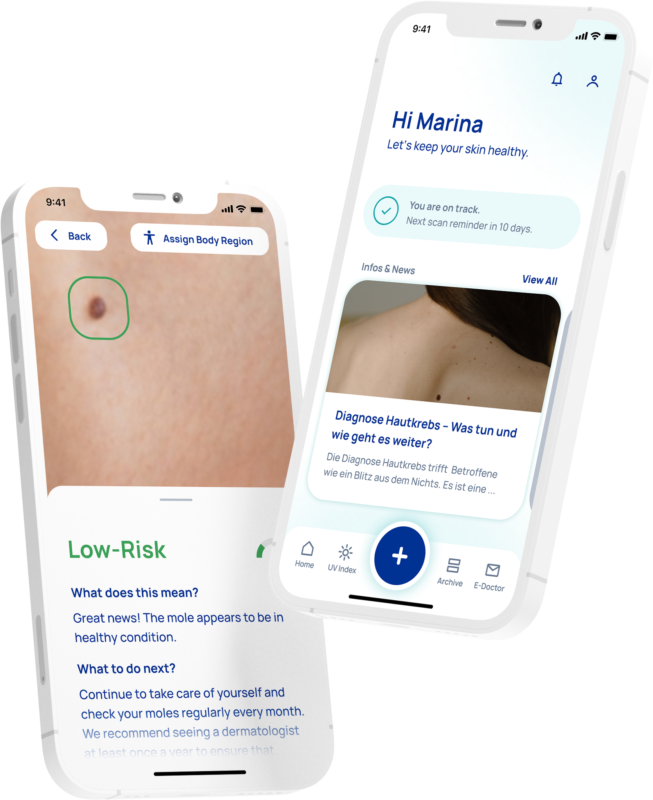Skin cancer - knowledge is your best defense
Every year, the number of people suffering from skin cancer increases worldwide. It now affects 1 in 5 people in Europe and North America, and as many as 2 in 3 in Australia. Unlike other cancers, skin cancer is visible and palpable and, if detected early, can almost always be cured.
Skin cancer
Skin cancer is the uncontrolled growth of abnormal cells in the epidermis, also called the epidermis, caused by unrepaired DNA damage. When the skin is too damaged it can no longer repair itself, thus increasing the risk of skin cancer and causing mutations in the cells. These mutations cause the skin cells to multiply rapidly and form malignant tumors.
Basal cell carcinoma is the most common skin cancer. Together with squamous cell carcinoma, they are called white skin cancer and do not metastasize as frequently.
The most dangerous skin cancer is black skin cancer, which is technically called malignant melanoma. This particularly malignant skin tumor forms metastases at an early stage and can then often no longer be cured.
What triggers skin cancer?
Generally, a distinction is made between white and black skin cancer. White skin cancer is the most common malignant cancer in humans, with the number of diagnoses constantly increasing. The main forms of white skin cancer, basal cell carcinoma (BCC) and squamous cell carcinoma (SCC), account for about 99% of all cases.
Malignant melanoma is the most dangerous of all skin cancers. Furthermore, it is occurring more and more frequently. Of great concern is the fact that black skin cancer is one of the most common tumors in people between the ages of 20 and 29. Melanoma is particularly dangerous at a late stage, because that is when it metastasizes and spreads throughout the body.
Signs and symptoms
White skin cancer
The signs and appearance of white skin cancer are very diverse. For laypersons, malignant skin lesions are often difficult to distinguish from benign ones. Look for the following characteristics:
- a small, porcelain-like pimple that has tiny blood vessels on the surface,
- a hollow with a wall-like edge,
Nodes that break open and form a crust,
rough skin changes with - a sharply defined reddening,
Black skin cancer
Early detection and regular self-monitoring is especially important for black skin cancer. Therefore, you should pay special attention to the following signs:
- new moles,
- Moles that clearly stand out from others,
- Moles with different shades,
- Moles that have changed over time,
- larger moles,
- burning, itching and bleeding moles.
Artificial intelligence for early detection of skin cancer now available to everyone
The most important cause of skin cancer is considered to be heavy, recurrent UV exposure with sunburns, with sun exposure in childhood and adolescence playing a particularly important role. How much UV radiation the skin can tolerate varies from person to person. There are 6 skin types in total and people with a fair skin type get sunburned very quickly on unprotected skin.
Meet our Partner
Our partner ecosystem offers customer solutions tailored to every need. Together, we build lifelong connections with our customers.






Prevention
The main advantages of early detection of skin cancer can be easily illustrated. The earlier skin cancer is detected, the better the possible course of the disease and the chance of cure. Treatment of malignant skin tumors is easier and better at an early stage than at a late stage.
Accurate and regular self-examination of the entire body helps detect black and white skin cancer early. Dermatologists worldwide recommend performing a self-examination once a month, paying close attention to and memorizing the various features of the skin. This allows changes to be detected earlier. New technologies such as smartphone apps support and facilitate self-examination.
An important factor of skin cancer prevention is the annual skin check by the dermatologist. During this procedure, each birthmark is closely examined with a reflected-light microscope (dermatoscope). This modern examination method is completely painless and allows physicians to accurately analyze details and structures of the surface of suspicious moles.


